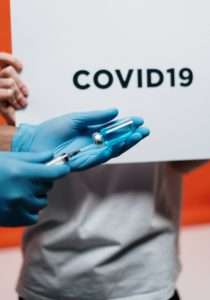There’s misinformation everywhere about COVID-19. Jay Harold wanted to give you some of the latest thinking from one of the most trusted sources in medicine today. The Infectious Diseases Society of America Guidelines was last updated on Dec. 2, 2020, and is carefully peer-reviewed by esteemed medical professionals. This post ”Treatment and Management of Patients with COVID-19?” reprints the executive summary seeks to provide current and relevant information from a trusted source.
Executive Summary
Coronavirus disease 2019 (COVID-19) is a pandemic with a rapidly increasing incidence of infections and deaths. Many pharmacologic therapies are being used or considered for treatment. Given the rapidity of emerging literature, the Infectious Diseases Society of America1 (IDSA) identified the need to develop a living, frequently updated evidence-based guidelines to support patients, clinicians, and other health-care professionals in their decisions about treatment and management of patients with COVID-19.
Summarized below are the recommendations with comments related to the clinical practice guideline for the treatment and management of COVID-19. A detailed description of background, methods, evidence summary, and rationale that support each recommendation, and research needs can be found online in the full text. In brief, per Grading of Recommendations Assessment, Development and Evaluation (GRADE) methodology, recommendations are labeled as “strong” or “conditional”. The word “recommend” indicates strong recommendations and “suggest” indicates conditional recommendations. In situations where promising interventions were judged to have insufficient evidence of benefit to support their use and with potential appreciable harms or costs, the expert panel recommended their use in the context of a clinical trial. These recommendations acknowledge the current “knowledge gap” and aim at avoiding premature favorable recommendations for potentially ineffective or harmful interventions.
- Recommendation 1: Among patients with COVID-19, the IDSA guideline panel recommends against hydroxychloroquine. (Strong recommendation, moderate certainty of the evidence)
- Remark: Chloroquine is considered to be class equivalent to hydroxychloroquine.
- Recommendation 2: Among hospitalized patients with COVID-19, the IDSA guideline panel recommends against hydroxychloroquine plus azithromycin. (Strong recommendation, low certainty of the evidence)
- Remark: Chloroquine is considered to be class equivalent to hydroxychloroquine.
- Recommendation 3: Among hospitalized patients with COVID-19, the IDSA guideline panel recommends against the use of the combination lopinavir/ritonavir. (Strong recommendation, moderate certainty of the evidence)

- Recommendation 4: Among hospitalized critically ill patients* with COVID-19, the IDSA guideline panel recommends dexamethasone rather than no dexamethasone. (Strong recommendation, moderate certainty of the evidence)
- Remark: If dexamethasone is unavailable, equivalent total daily doses of alternative glucocorticoids may be used. Dexamethasone 6 mg IV or PO for 10 days (or until discharge) or equivalent glucocorticoid dose may be substituted if dexamethasone is unavailable. Equivalent total daily doses of alternative glucocorticoids to dexamethasone 6 mg daily are methylprednisolone 32 mg and prednisone 40 mg.
- *Critical illness is defined as patients on mechanical ventilation and ECMO. Critical illness includes end-organ dysfunction as is seen in sepsis/septic shock. In COVID-19, the most commonly reported form of end-organ dysfunction is ARDS
- Recommendation 5: Among hospitalized patients with severe**, but non-critical, COVID-19, the IDSA guideline panel suggests dexamethasone rather than no dexamethasone. (Conditional recommendation, moderate certainty of the evidence)
- Remark: Dexamethasone 6 mg IV or PO for 10 days (or until discharge) or equivalent glucocorticoid dose may be substituted if dexamethasone is unavailable. Equivalent total daily doses of alternative glucocorticoids to dexamethasone 6 mg daily are methylprednisolone 32 mg and prednisone 40 mg.
- **Severe illness is defined as patients with SpO2 ≤94% on room air, including patients on supplemental oxygen.
- Recommendation 6: Among hospitalized patients with non-severe*** COVID-19 without hypoxemia requiring supplemental oxygen, the IDSA guideline panel suggests against the use of glucocorticoids. (Conditional recommendation, low certainty of the evidence)
- ***Non-severe illness is defined as a patient with a SpO2 > 94% not requiring supplemental oxygen.
- Recommendation 7: Among patients who have been admitted to the hospital with COVID-19, the IDSA guideline panel suggests against the routine use of tocilizumab. (Conditional recommendation, low certainty of the evidence)
- Recommendation 8: Among patients who have been admitted to the hospital with COVID-19, the IDSA guideline panel recommends COVID-19 convalescent plasma only in the context of a clinical trial. (Knowledge gap)
- Recommendation 9: In hospitalized patients with severe* COVID-19, the IDSA panel suggests remdesivir over no antiviral treatment. (Conditional recommendation, moderate certainty of the evidence)
- Remark: For consideration in contingency or crisis capacity settings (i.e., limited remdesivir supply): Remdesivir appears to demonstrate the most benefit in those with severe COVID-19 on supplemental oxygen rather than in patients on mechanical ventilation or ECMO.
- *Severe illness is defined as patients with SpO2 ≤94% on room air, and those who require supplemental oxygen, mechanical ventilation, or ECMO.
- Recommendation 10: In patients on supplemental oxygen but not on mechanical ventilation or ECMO, the IDSA panel suggests treatment with five days of remdesivir rather than 10 days of remdesivir. (Conditional recommendation, low certainty of the evidence)
- Remark: In patients on mechanical ventilation or ECMO, the duration of treatment can be 10 days.
- Recommendation 11: Among patients with severe COVID-19 on supplemental oxygen but not on mechanical ventilation or ECMO, the IDSA panel suggests treatment with five days of remdesivir rather than 10 days of remdesivir. (Conditional recommendation, low certainty of the evidence)

- Recommendation 12: Among hospitalized patients with severe COVID-19, the IDSA panel suggests against famotidine use for the sole purpose of treating COVID-19 outside of the context of a clinical trial. (Conditional recommendation, very low certainty of the evidence)
- Recommendation 13: Among ambulatory patients with COVID-19, the IDSA guideline panel suggests against the routine use of bamlanivimab. (Conditional recommendation, Very low certainty of the evidence)
- Remark: In patients at increased risk (as defined by the United States Food and Drug Administration [FDA] Emergency Use Authorization [EUA]), bamlanivimab is a reasonable treatment option if, after informed decision-making, the patient puts a high value on the uncertain benefits and a low value on uncertain adverse events.
Since the inception of its work, the panel has expressed the overarching goal that patients be recruited into ongoing trials, which would provide much-needed evidence on the efficacy and safety of various therapies for COVID-19. The panel has determined that when an explicit trade-off between highly uncertain benefits and known putative harms of these therapeutic agents were considered, a net positive benefit was not reached and could possibly be negative (risk of excess harm). The panel acknowledges that enrolling patients in randomized controlled trials (RCTs) might not be feasible for many frontline providers due to limited access and infrastructure. Should the lack of access to clinical trials exist, we encourage setting up local or collaborative registries to systematically evaluate the efficacy and safety of drugs to contribute to the knowledge base. Each clinician can play a role in advancing our understanding of this disease through a local registry or other data collection efforts.
Background
The first cases of COVID-19 were reported from Wuhan, China in early December 2019 [1], now known to be caused by a novel beta-coronavirus, named Severe acute respiratory syndrome

coronavirus 2 (SARS-CoV-2). Within a span of months, COVID-19 has become pandemic due to its transmissibility, spreading across continents with the number of cases and deaths rising daily [2]. Although most infected individuals exhibit a mild illness (80%+), 14% have serious and 5% have a critical illness. Approximately 10% will require hospital admission due to COVID-19 pneumonia, of which approximately 10% will require ICU care, including invasive ventilation due to acute respiratory distress syndrome (ARDS) [3]. While mortality appears to be more common in older individuals and those with comorbidities, such as chronic lung disease, cardiovascular disease, hypertension, and diabetes, young people with no comorbidities also appear to be at risk for critical illness including multi-organ failure and death.
There has been an expanding number of studies rapidly published online and in academic journals; however, some of these may be of limited quality and are pre-published without sufficient peer-review. Critical appraisal of the existing studies is needed to determine if the existing evidence is sufficient to support currently proposed management strategies.
Given the rapid global spread of SARS-CoV-2 and the difficulty for the overburdened front-line providers and policymakers to stay up to date on emerging literature, IDSA has recognized the necessity of developing a rapid guideline for the treatment of COVID-19. The guideline panel is using a methodologically rigorous process for evaluating the best available evidence and providing treatment recommendations. Two additional guidelines on diagnostic testing and infection prevention also have been developed. These guidelines will be frequently updated as substantive literature becomes available and are accessible on an easy to navigate web and device interface at http://www.idsociety.org/covid19guidelines.
There continue to be several ongoing trials evaluating therapeutic agents for the treatment of COVID-19. As data becomes available from these trials and if there is a preponderance of evidence to suggest the use of a therapeutic agent even in the context of clinical trials is no longer warranted it will be removed from future updates of the guideline (and the removal will be noted in the updated guidelines). If there is emerging evidence on the efficacy or safety of a therapeutic agent not mentioned in the current version of the guideline it will be included in future updates of the guideline.
These recommendations are intended to inform patients, clinicians, and other health professionals by providing the latest available evidence.
Jay Harold hopes you enjoyed this post, “Treatment and Management of Patients with COVID-19.” Please share it and read more about Jay Harold here. Please take this advice from Muhammad Ali and give back to others. “Service to others is the rent you pay for your room here on earth.”




